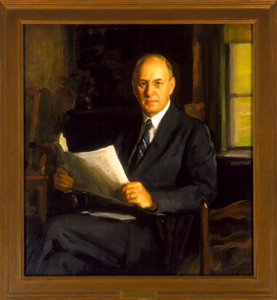Having served as head of the Farm Credit Administration in 1933, Henry Morgenthau (1891 - 1967) was appointed Secretary of the Treasury by President Franklin D. Roosevelt in 1934, continuing briefly under President Harry Truman. As Roosevelt's Secretary, Morgenthau was instrumental in setting up the Works Progress Administration and the Public Works of Art Project in the 1930's. To finance World War II, Morgenthau initiated an elaborate system of marketing war bonds. He arranged that the Federal Reserve would support Treasury borrowing and would purchase bonds not bought by the public at an agreed rate. The War Bond program raised 49 billion dollars towards the cost of the war.

Sec. Henry Morgenthau, Jr.
David Silvette
Oil on canvas
1936
51 1/2 x 47 1/4 x 1 3/4"
P.1935.1
Morgenthau made his most significant contribution as Chairman of the Bretton Woods Conference in New Hampshire, in 1944. This Conference, the keystone of postwar international finance, established the International Monetary Fund and the International Bank for Reconstruction and Development (World Bank) and pegged all international currencies to the dollar, which was in turn pegged to gold. Morgenthau resigned shortly after the accession of Truman to the Presidency.
About the Artist
Born in Richmond, Virginia in 1909, David Silvette (1909 - 1992) received his first artistic training from his father, Ellis M. Silvette, a portrait painter. David later studied with Cecelia Beaux and Charles Hawthorne. This portrait of Henry Morgenthau was painted in the dining room of Morgenthau's Hyde Park house during the summer of 1936. Morgenthau and his advisors were meeting at Hyde Park to discuss various candidates for the vacant position of Assistant Secretary, most of whom were rejected for fear they would take orders from Wall Street. During one of the portrait sittings, Morgenthau asked David Silvette to make a change in the painting, to which Silvette replied, "Mr. Secretary, I know what I am doing." One of Morgenthaus' advisors, who had observed this exchange, suggested, "Why don't we get that artist as Assistant Secretary, he won't take orders from anyone." The portrait was so liked by Morgenthau that he was reluctant to give it up to the Treasury Department. He kept the painting until 1945, when he retired as Secretary.
